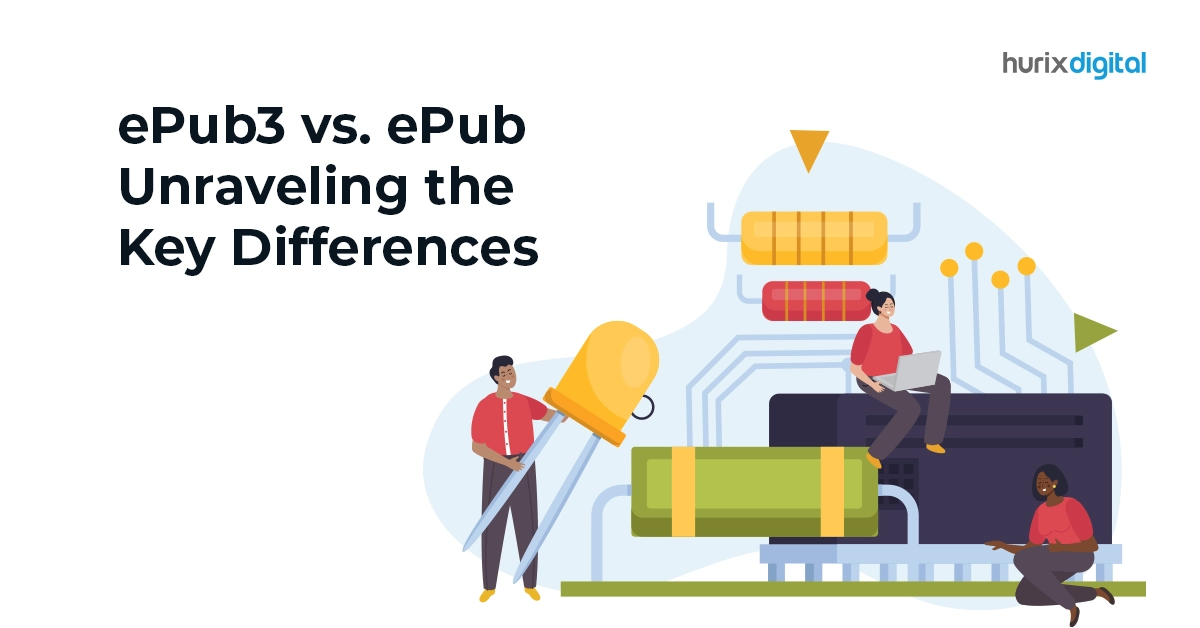ePub3 vs. ePub Unraveling the Key Differences
In the ever-evolving landscape of digital publishing, understanding the differences between ePub3 and ePub formats is crucial. Both formats serve as standards for creating digital books, but they have distinct features and functionalities that cater to different needs. In this article, we’ll unravel the key differences between ePub vs. ePub3, explore their features, advantages, and interactivity, and provide insights into which format might be suitable for your digital publishing endeavors.
Table of Contents:
- ePub vs. ePub3: Exploring the Distinctions
- Demystifying The ePub Standard
- Unlocking Richness and Interactivity with ePub3
- Understanding ePub Standard
- ePub3 Advantages and Features
- Interactive eBooks: ePub3 Interactivity
- ePub Format Comparison: Which One to Choose?
- ePub3 Differences and Interactivity
- How Hurix Digital Can Help
- Conclusion
ePub vs. ePub3: Exploring the Distinctions
ePub, short for electronic publication, has been the standard format for digital books for quite some time. It offers a range of features that make it versatile for various reading devices. On the other hand, ePub3 is an enhanced version that introduces advanced features and capabilities to create more interactive and engaging eBooks.
Demystifying The ePub Standard
Introduced as a distribution format maximizing text reflow across early e-readers and basic phones, the dated ePub standard relied solely on XHTML markup coupled with 2D PNG images wrapped in proprietary DRM protection ligands.
While economical, first-gen ePubs severely limited control over:
❌ Fixed Layout Retention – Word flow changes would break sophisticated designs unsuited to reflowing.
❌ Element Positioning Accuracy – Restrictive positioning hampered pixel-perfect graphical arrangements.
❌ Multimedia Flexibility – No native video/audio embed functionalities were facilitated hampering innovation.
While suitable light-weight novels, navigational complexity or visual poetry posed challenges without reengineering entire manuscripts structurally – a tradeoff between simplicity and creative limitations.
School textbooks, travelogues and illustrated narrations stood particularly hampered by such constraints challenging comprehension. Hence the need arose to expand creative horizons without losing device friendliness strengths!
Also Read: How ePUB Solutions Streamline Large Scale Digital Publishing Projects
Unlocking Richness and Interactivity with ePub3
Formally standardized in late 2014 after years of development, ePub3 transformed digital publishing by introducing native support for:
✅ HTML5 Elements: Modern web markup expanded semantic expression while retaining accessibility compliance through new elements like Canvas, MathML and SVG that simplify positioning, complex visualizations and precision animations.
✅ Integrated Media: Direct video and audio integration without processor dependencies now enabled multimedia augmentation uplifting engagement quotients for complex topics.
✅ Script Injection: JavaScript opened doors for expansive interactivities like assessments, 3D widgets and hidden element reveals tailored for touchscreens once avoided to minimize risks.
✅ Layout Control: Guided flows using FXL standards help retain print layouts using multi-column articles with text wrapping around images facilitating novel and magazine conversions retaining source fidelity.
This new dimension unshackled publishers, education houses and even marketing from constraints once forcing overly structured content while serving mobile screens. Truly a reincarnation catapulting eBooks onto the digital content playing field!
Also Read: Which is the Better Format for ePublishing in 2024?
Understanding ePub Standard
The ePub standard revolutionized the way digital books are created and consumed. It provides a structured format for content presentation, including text, images, and multimedia elements. With ePub, readers can enjoy a consistent reading experience across different devices, thanks to its reflowable layout.
ePub3 Advantages and Features
ePub3 takes digital publishing to the next level with its enhanced features and functionalities. One of the significant advantages of ePub3 is its support for interactive elements such as audio, video, and animations. This allows publishers to create more immersive reading experiences for their audience.
Interactive eBooks: ePub3 Interactivity
One of the key differences between ePub and ePub3 lies in their approach to interactivity. While ePub supports basic interactive elements, ePub3 offers a broader range of options for incorporating multimedia and interactive features into eBooks. This includes interactive quizzes, multimedia widgets, and dynamic content updates.
ePub Format Comparison: Which One to Choose?
When deciding between ePub vs. ePub3, it’s essential to consider your publishing needs and target audience. If you’re looking to create traditional eBooks with text and images, ePub might suffice. However, if you want to take advantage of advanced multimedia features and create interactive eBooks, ePub3 is the way to go.
Also Read: EPUB vs. MOBI vs. PDF: Which eBook Format is Right For You?
ePub3 Differences and Interactivity
ePub3 sets itself apart from its predecessor with its focus on interactivity and dynamic content. Publishers can leverage ePub3’s features to create engaging educational materials, interactive children’s books, and immersive multimedia experiences. The possibilities are endless with ePub3’s enhanced capabilities.
How Hurix Digital Can Help
At Hurix Digital, we specialize in digital publishing solutions that empower publishers to create, distribute, and monetize their content effectively. Whether you’re looking to transition to ePub3 or optimize your eBook publishing strategy, our team of experts can guide you every step of the way. Contact us today to learn more about how we can help you elevate your digital publishing efforts.
Conclusion
In conclusion, understanding the differences between ePub vs. ePub3 is essential for publishers looking to leverage digital publishing effectively. While ePub serves as a standard format for digital books, ePub3 offers advanced features and interactivity that can enhance the reading experience. By considering your publishing needs and audience preferences, you can make informed decisions about which format to choose.

Gokulnath B is the Associate Vice President – Editorial Services. He is PMP, CSM, and CPACC certified and has 20+ years of experience in Project Management, Delivery Management, and managing the Offshore Development Centre (ODC).









